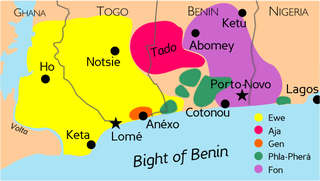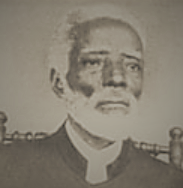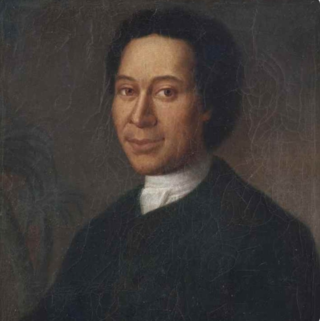In articulatory phonetics, a consonant is a speech sound that is articulated with complete or partial closure of the vocal tract, except for the h, which is pronounced without any stricture in the vocal tract. Examples are and [b], pronounced with the lips; and [d], pronounced with the front of the tongue; and [g], pronounced with the back of the tongue;, pronounced throughout the vocal tract;, [v], and, pronounced by forcing air through a narrow channel (fricatives); and and, which have air flowing through the nose (nasals). Contrasting with consonants are vowels.

The Kwa languages, often specified as New Kwa, are a proposed but as-yet-undemonstrated family of languages spoken in the south-eastern part of Ivory Coast, across southern Ghana, and in central Togo. The Kwa family belongs to the Niger-Congo phylum. The name was introduced 1895 by Gottlob Krause and derives from the word for 'people' (Kwa) in many of these languages, as illustrated by Akan names. This branch consists of around 50 different languages spoken by about 25 million people. Some of the largest Kwa languages are Ewe, Akan and Baule.

A digraph or digram is a pair of characters used in the orthography of a language to write either a single phoneme, or a sequence of phonemes that does not correspond to the normal values of the two characters combined.

Marshallese, also known as Ebon, is a Micronesian language spoken in the Marshall Islands. The language of the Marshallese people, it is spoken by nearly all of the country's population of 59,000, making it the principal language. There are also roughly 27,000 Marshallese citizens residing in the United States, nearly all of whom speak Marshallese, as well as residents in other countries such as Nauru and Kiribati.

Fon is the language of the Fon people. It belongs to the Gbe group within the larger Atlantic–Congo family. It is primarily spoken in Benin, as well as in Nigeria, Togo, Ghana and Gabon, by approximately 2.28 million speakers. Like the other Gbe languages, Fon is an isolating language with a SVO basic word order.
The Ligbi people speak a Mande language in Ghana, in the north-west corner of the Brong-Ahafo Region. Ligbi is spoken by approximately 10,000 speakers. It is fairly closely related to Jula, Vai and Kono. A small population of Ligbi speakers is reported to live in Ivory Coast. Ligbi is also known as Wela (Hwela) or Numu. The latter of these refers to a subsection of the Ligbi people; Numu is Dyula for 'blacksmith'.
The Dangme language, also Dangme or Adaŋgbi, is a Kwa language spoken in south-eastern Ghana by the Dangme People (Dangmeli). The Dangmeli are part of the larger Ga-Dangme ethnic group. Klogbi is a variant, spoken by the Kloli. Kropp Dakubu (1987) is the most thorough grammar of the language.
Logba is a Kwa language spoken in the south-eastern Ghana by approximately 7,500 people. The Logba people call themselves and their language Ikpana, which means ‘defenders of truth’. Logba is different from Lukpa of Togo and Benin, which is also sometimes referred to as Logba.
The voiced labial–velar nasal is a type of consonantal sound, used in some spoken languages. The symbol in the International Phonetic Alphabet that represents this sound is ⟨ŋ͡m⟩.
The Gonja language, properly called Ngbanya or Ngbanyito, is a North Guang language spoken by an estimated 230,000 people, almost all of whom are of the Gonja ethnic group of northern Ghana. Related to Guang languages in the south of Ghana, it is spoken by about a third of the population in the northern region. The Brong-Ahafo and Volta regions lie to the south of the Gonja-speaking area, while Dagombas, Mamprussis and Walas are to the north. Its dialects are Gonja and Choruba.

Carl Christian Reindorf was a Euro-African-born pioneer historian, teacher, farmer, trader, physician and pastor who worked with the Basel Mission on the Gold Coast. He wrote The History of the Gold Coast and Asante in the Ga language; scholars consider the book a “culturally important” work and an increasingly important source for Ghanaian history. The work was later translated into English and published in 1895 in Switzerland. He used written sources and oral tradition, interviewing more than 200 people in the course of assembling his history.

Fante, also known as Fanti, Fantse, or Mfantse, is one of the four principal members of the Akan dialect continuum, along with Asante, Bono and Akuapem, the latter three collectively known as Twi, with which it is mutually intelligible. It is principally spoken in the central and southern regions of Ghana as well as in settlements in other regions in western Ghana, Ivory Coast, as well as in Liberia, Gambia and Angola.
Guéré (Gere), also called Wè (Wee), is a Kru language spoken by over 300,000 people in the Dix-Huit Montagnes and Moyen-Cavally regions of Ivory Coast.
Farefare or Frafra, also known by the regional name of Gurenne (Gurene), is a Niger–Congo language spoken by the Frafra people of northern Ghana, particularly the Upper East Region, and southern Burkina Faso. It is a national language of Ghana, and is closely related to Dagbani and other languages of Northern Ghana, and also related to Mossi, also known as Mooré, the national language of Burkina Faso.
Kuteb also known as Ati, Kutev, Mbarike is a Nigerian ethnic language. The Kuteb people mostly live in the southern part of Taraba state in Nigeria, with a thousand-or-so speakers across the border in Cameroon. In Nigeria, it is spoken mostly in Takum and Ussa LGAs, and Yangtu SDA Taraba State.

Johannes Zimmermann was a missionary, clergyman, translator, philologist and ethnolinguist of the Basel Evangelical Missionary Society of Switzerland, who translated the entire Bible into the Ga language of the Ga-Dangme people of southeastern Ghana and wrote a Ga dictionary and grammar book. Mostly an oral language before the mid-nineteenth century, the Ga language assumed a written form as a result of his literary work. Zimmerman's work built upon the single introductory grammatical treatise written by the Euro-African Moravian missionary and educator, Christian Jacob Protten, in the Ga and Fante languages, and published a century earlier in Copenhagen, in 1764.
The Salem School, Osu, or the Osu Presbyterian Boys’ Boarding School or simply, Osu Salem, formerly known as the Basel Mission Middle School, is an all boys’ residential middle or junior secondary school located in the suburb of Osu in Accra, Ghana. The Salem School was the first middle school and the first boarding school to be established in Ghana. The school was founded under the auspices of the Basel Mission in 1843 and supervised by three pioneering missionaries and schoolmasters, Jamaican, Alexander Worthy Clerk and Angolan-born Jamaican Catherine Mulgrave together with the German-trained Americo-Liberian George Peter Thompson.

Regina Hesse (1832–1898), also Rottmann, was a Euro-African schoolteacher in colonial Ghana. As an educationist, she was one of first women exemplars on the Gold Coast to become a school administrator. Hesse was trained by the Angolan-born Jamaican Moravian pioneer woman teacher, Catherine Mulgrave who set up three girls’ specialist boarding schools at Osu, Abokobi and Odumase and was active in the women's Christian ministry in Christiansborg, Accra.

Christian Jacob Protten also Christian Jakobus Africanus Protten or Uldrich was a Euro-African Moravian missionary pioneer, linguist, translator and educationalist-administrator in Christiansborg on the Danish Gold Coast in the eighteenth century. The first recorded grammatical treatise in the Ga and Fante languages was written by Protten and published in Copenhagen in 1764.
Mary Esther Kropp Dakubu was an American linguist based in Ghana, known for her work on Ghanaian languages. She was professor emerita at the Institute of African Studies at the University of Ghana, where she had been affiliated since 1964.








